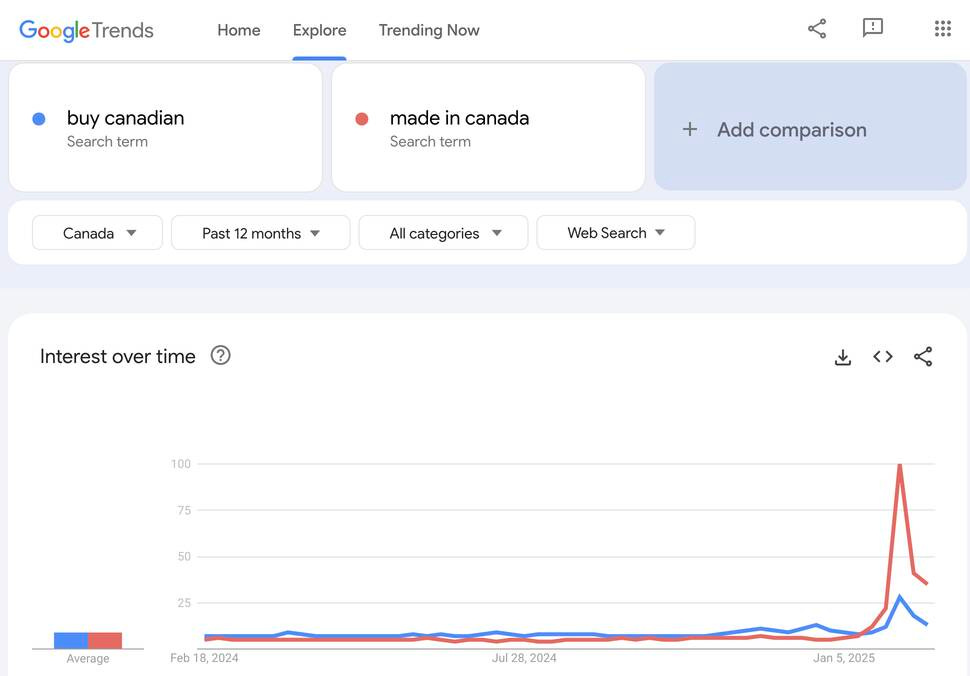I’m continuing on my travel in Mexico. Thanks for your patience as today’s newsletter is delayed by few hours.
As someone who’s always interested in the Economy and Markets, I can’t help but ask around the people I run into during traveling.
For most people I have spoken with here in Mexico, they are going on with life as normal.
I ask: Are you worried about the tariffs Trump threatened?
Most seemed to make peace with it.
.
Perhaps they can’t do much about it, can’t worry about something when there’s not much one can do.
Perhaps they have a different attitude toward the entire situation. It is the way it is.
In Canada, we have seen Canadian pride spike to a new level not seen in years.
Check out the searches for “Buy Canadian” or “Made in Canada” spiked on Google since the Trump tariff threatening announcement.
I do love this new sense of Canadian pride.
It seems that Canadians have had a much stronger reactions compared to Mexicans.
Who says Canadians are nice all the time?
.
Emotions is the #1 enemy to your investment returns.
One thing I like to do is to separate the emotions from facts.
I’ve paid for that lesson over and over in my younger days of investing. Letting emotions run ahead of good methodical thinking.
Selling stocks too early or selling too late.
All because of letting fears getting the best of me.
Mastering emotions in investing is not easy to do, but an important skill to master.
.
Let’s take a look at the newly announced Steel and Aluminum Tariffs by Trump, raising the tariff from 10% to 25% effective on March 12, 2025.
Let’s look at the early response to this announcement so far.
In an article published on Manufacturing Dive - Steel tariffs could drive up domestic prices and capacity, but unlikely to create jobs
Higher tariffs could push more manufacturers to turn to the domestic steel market, which could drive up prices and push steelmakers to increase domestic production capacity, Husisian said.
Metal recycler Greenwave Technology Solutions, which supplies steel mills with recycled materials including steel and aluminum, is already seeing prices for scrap metal rise, with prices up 10% so far this month, according to CFO Isaac Dietrich.
The official tariffs haven’t even kicked in, yet, the price has already been climbing.
With a 10% increase in US domestic scrap metal, that effectively bring the impact of the newly announced tariff increase to only 5%.
.
Why only 5%?
Let’s break this down:
The current tariff is at 10% (you can read about it here)
That means the net increase in tariff is 15%:
25% - 10% = 15%
The tariff is resulting an increase in demand for the metal domestically within US. That pushes up the price in the US, not anywhere else in the world.
In this case, the price has increased by 10%, leaving the actual net impact of the new tariff at 5%:
15% - 10% = 5%
.
Now, I don’t proclaim to be an expert at tariffs or the Steel and Aluminum industry.
What I’m good at doing is seeing things with a different light.
This is why most economists are saying it is difficult to predict the outcome of implementing tariffs.
The global supply chain is very complex.
It’s not as simple as throwing out a tariff and everything will work out the way it’s intended.
In this very rough math demonstration, it shows that the impact of tariffs may be smaller.
As domestic US Steel and Aluminum price increase, it makes it less expensive to import foreign Steel and Aluminum even at a higher tariff.
The ones who are impacted are the American people.
The very people Trump is trying to “help”.
This is a delicious Mole dish I ordered at a Michelin featured restaurant in Oaxaca, Mexico - Las Quince Letras
Maybe Mexicans got it right with how to react to Trump’s tariff threats?
If you like my work, I invite you to share it with others.
Eric Chang
Oaxaca de Juárez, Mexico
February 18, 2025
Copyright © 2025 Why Alberta Now.
No part of this publication may be reproduced, distributed, or transmitted in any form or by any means, including photocopying, recording, or other electronic or mechanical methods, without the prior written permission of the publisher, except in the case of brief quotations embodied in critical reviews and certain other noncommercial uses permitted by copyright law.
The information provided herein is believed to be accurate and reliable, but Why Alberta Now does not guarantee its accuracy or completeness. The content is for informational purposes only and is not intended to be a substitute for professional financial advice. Why Alberta Now is not a financial advisor and does not provide personalized financial advice. The views and opinions expressed in this publication are those of the author and do not necessarily reflect the official policy or position of Why Alberta Now. The content may be subject to change without notice and may become outdated over time. Why Alberta Now is under no obligation to update or revise any information presented herein.
Investments involve risks, and individuals should consult with a qualified financial advisor before making any investment decisions. Prospective investors should carefully consider the investment objectives, risks, charges, and expenses of any investment before investing.





